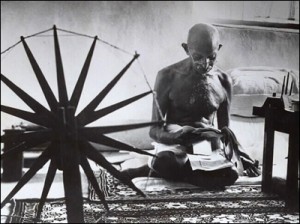 The charkha, or spinning wheel, was the physical embodiment and symbol of Gandhi’s constructive program. It represents Swadeshi, self-sufficiency, and at the same time interdependence, because the wheel is at the center of a network of cotton growers, carders, weavers, distributors, and users. . It also embodied the dignity of labor, equality, unity, as all volunteers were to spin each day, and finally independence, as British control of India was rooted in control of indigenous industries such as textiles. For this reason, Nehru called khadi the homespun cloth “the livery of our freedom.”
The charkha, or spinning wheel, was the physical embodiment and symbol of Gandhi’s constructive program. It represents Swadeshi, self-sufficiency, and at the same time interdependence, because the wheel is at the center of a network of cotton growers, carders, weavers, distributors, and users. . It also embodied the dignity of labor, equality, unity, as all volunteers were to spin each day, and finally independence, as British control of India was rooted in control of indigenous industries such as textiles. For this reason, Nehru called khadi the homespun cloth “the livery of our freedom.”
Spinning formed the “sun” in the “solar system” that was Gandhi’s Constructive Programme. Almost every person, regardless of age, social class or gender, was involved in spinning and sometimes elsewhere in the chain of cloth production, from sowing the seeds of cotton to wearing khadi. Spinning was both symbolic and quite real, as it gave employment to millions and produced a basic need of Gandhian economics.
What would be the charkha of our movement today? Meditation can be regarded as our inner charkha and it’s expression is the raising of the human image. The Metta Center Roadmap is designed to facilitate finding constructive activities that would unite and represent our movement as brilliantly as charkha did in India. This is why the Metta Center logo is derived from the charkha.








